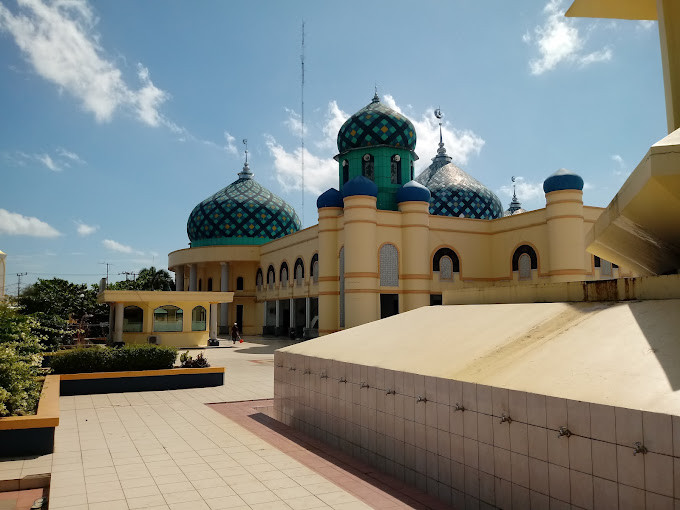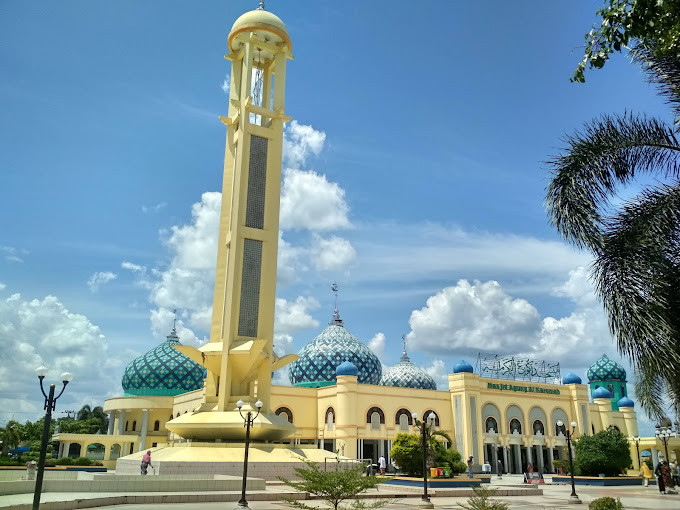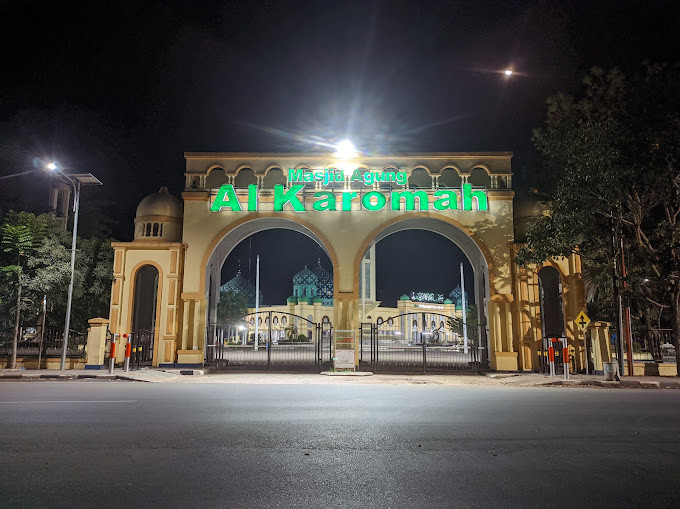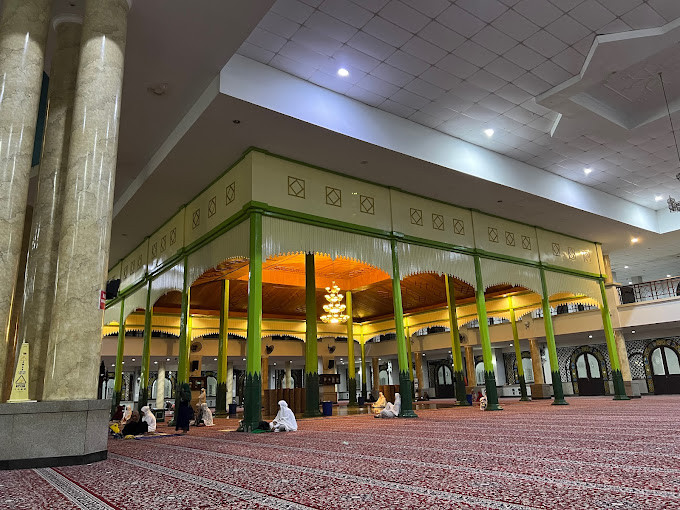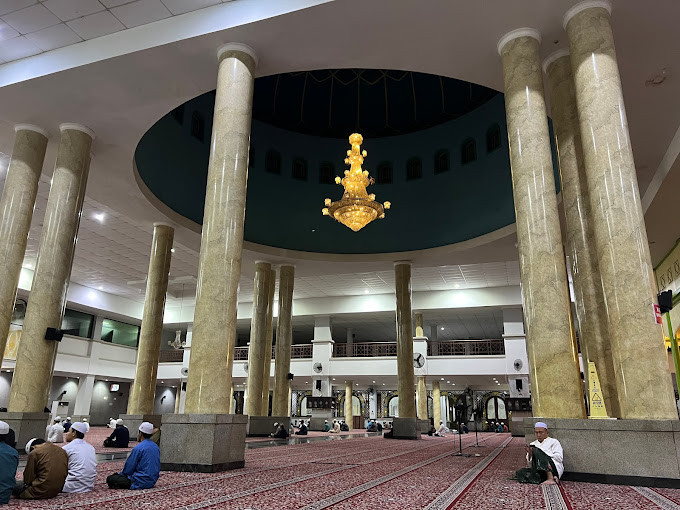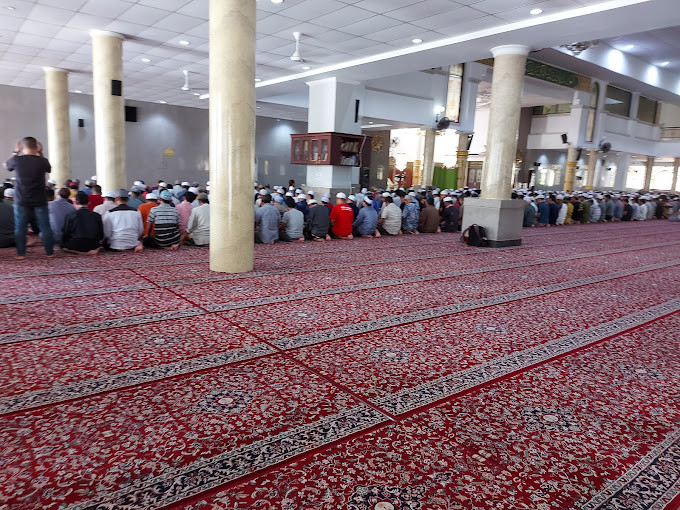Al-Karomah Grand Mosque
History
As the center of the Banjar Kingdom , Martapura was recorded as witnessing 12 ruling sultans . At that time the mosque functioned as a place of worship, Islamic da'wah, integration of Muslims and the headquarters or fortress of the fighters against the Dutch. Due to the burning of Kampung Pasayangan and the Martapura Mosque, a desire arose to build a bigger mosque. In 1280 Hijriyah or 1863 AD, the construction of the mosque began.
The Great Mosque of Al Karomah, formerly known as the Jami' Martapura Mosque , which was founded by the mosque construction committee, namely HM. Nasir, H.M. Taher (Datu Rich), HM. Afif (Datu Hedgehog) . This committee was supported by Raden Tumenggung Kesuma Yuda and Mufti HM Noor.
According to his history, Datuk Landak was entrusted with looking for ironwood as a pillar of the mosque, to the Barito area, Central Kalimantan . After the ulin pole is at the location of the mosque building, it is agreed.
Exactly 10 Rajab 1315 H ( 5 December 1897 AD) the construction of the Jami' Mosque began. Technically the mosque building is a building with the main structure of ironwood with shingle roofs, ironwood plank walls and floors. Along with the changing times from time to time the mosque is always being renovated, but the main structure has not changed. [2]
Monday night 12 Rabiul Awal 1415 H in celebration of the birthday of the Great Prophet Muhammad SAW , the Jami' Martapura Mosque was inaugurated as the Great Al Karomah Mosque with a size of 37.5 meters x 37.5 meters.
Currently the Great Mosque of Al Karomah stands majestically with concrete construction and the roof frame is made of stainless steel , which is strung in a space frame structure . The dome is covered with enamel.
Inside the mosque, until now one can still find and see the main structure of the Jami Martapura Mosque which was not dismantled, so that it can be seen as historical evidence from the founding of the mosque.
Urban and Architectural
In terms of architecture, the shape of the Great Mosque of Al Karomah Martapura follows the Demak Mosque made by Sunan Kalijaga . The miniature was brought by a representative from Desa Dalam Pagar and the size was very neat and easily adjusted to the actual building because it was already on a scale.
This mosque has undergone three renovations, which currently follows the shape of a modern building. Even so, the four pillars of Ulin which became the Saka Guru, a relic of the first mosque building, are still being maintained amidst dozens of concrete pillars that spread throughout the mosque . The pulpit which is more than a century old is still functioning, where the pulpit of the mosque designed by HM Musyafa has carved flower strands and is in the form of a stage equipped with stairs
The architecture of the Great Mosque of Al Karomah Martapura which cost Rp. 27 billion in the last renovation around 2004 , adopted many Middle Eastern forms . Like the onion dome roof and Dutch style ornaments . Originally the roof of the mosque was conical with an overlapping roof construction, in the style of a traditional Banjar mosque. After several renovations, it finally turned into a dome shape.
The spatial pattern of the Great Al Karomah Mosque also adopts the spatial pattern of the architecture of the Great Mosque of Demak which was brought together with the introduction of Islam to this area by Khatib Dayan. Due to the expansion of the architecture of the Great Mosque of Demak, only four ulin pillars or also called four guru pillars from the old building remain.
The teacher's pillars are the pillars that enclose the cella or sacred space. The cella room which is covered by teacher pillars is in front of the mihrab room, which means that cosmologically the cella is more important than the mihrab. Historically, the guru pole four used a rope, aka seradang, which was pulled by Datuk Landak and the community. By the nature and iradat of God Almighty, the Four Pillars of the Guru were established.
Description
The Great Mosque of Al Karomah is a grand mosque located in Martapura , Banjar Regency , South Kalimantan and is the largest mosque in South Kalimantan . This mosque is also a land landmark of Martapura because it is easily accessible from all cities in South Kalimantan and is located on Jalan Ahmad Yani which is the main road (national road) between cities, especially from East Kalimantan (north direction) to Banjarmasin City .
References
https://id.wikipedia.org/wiki/Masjid_Agung_Al-Karomah
https://kalsel.antaranews.com/berita/234577/banjar-provides-ready-to-drink-water-facility-at-al-karomah-grand-mosque
Details
الموقع
Banjar , Indonesia
عدد المصليين
3000
المالك / المتبرع
Indonesian Mosque Council
المعماري
تاريخ البناء
1863
Area
7000
الرسومات المعمارية
الخريطة
History
As the center of the Banjar Kingdom , Martapura was recorded as witnessing 12 ruling sultans . At that time the mosque functioned as a place of worship, Islamic da'wah, integration of Muslims and the headquarters or fortress of the fighters against the Dutch. Due to the burning of Kampung Pasayangan and the Martapura Mosque, a desire arose to build a bigger mosque. In 1280 Hijriyah or 1863 AD, the construction of the mosque began.
The Great Mosque of Al Karomah, formerly known as the Jami' Martapura Mosque , which was founded by the mosque construction committee, namely HM. Nasir, H.M. Taher (Datu Rich), HM. Afif (Datu Hedgehog) . This committee was supported by Raden Tumenggung Kesuma Yuda and Mufti HM Noor.
According to his history, Datuk Landak was entrusted with looking for ironwood as a pillar of the mosque, to the Barito area, Central Kalimantan . After the ulin pole is at the location of the mosque building, it is agreed.
Exactly 10 Rajab 1315 H ( 5 December 1897 AD) the construction of the Jami' Mosque began. Technically the mosque building is a building with the main structure of ironwood with shingle roofs, ironwood plank walls and floors. Along with the changing times from time to time the mosque is always being renovated, but the main structure has not changed. [2]
Monday night 12 Rabiul Awal 1415 H in celebration of the birthday of the Great Prophet Muhammad SAW , the Jami' Martapura Mosque was inaugurated as the Great Al Karomah Mosque with a size of 37.5 meters x 37.5 meters.
Currently the Great Mosque of Al Karomah stands majestically with concrete construction and the roof frame is made of stainless steel , which is strung in a space frame structure . The dome is covered with enamel.
Inside the mosque, until now one can still find and see the main structure of the Jami Martapura Mosque which was not dismantled, so that it can be seen as historical evidence from the founding of the mosque.
Urban and Architectural
In terms of architecture, the shape of the Great Mosque of Al Karomah Martapura follows the Demak Mosque made by Sunan Kalijaga . The miniature was brought by a representative from Desa Dalam Pagar and the size was very neat and easily adjusted to the actual building because it was already on a scale.
This mosque has undergone three renovations, which currently follows the shape of a modern building. Even so, the four pillars of Ulin which became the Saka Guru, a relic of the first mosque building, are still being maintained amidst dozens of concrete pillars that spread throughout the mosque . The pulpit which is more than a century old is still functioning, where the pulpit of the mosque designed by HM Musyafa has carved flower strands and is in the form of a stage equipped with stairs
The architecture of the Great Mosque of Al Karomah Martapura which cost Rp. 27 billion in the last renovation around 2004 , adopted many Middle Eastern forms . Like the onion dome roof and Dutch style ornaments . Originally the roof of the mosque was conical with an overlapping roof construction, in the style of a traditional Banjar mosque. After several renovations, it finally turned into a dome shape.
The spatial pattern of the Great Al Karomah Mosque also adopts the spatial pattern of the architecture of the Great Mosque of Demak which was brought together with the introduction of Islam to this area by Khatib Dayan. Due to the expansion of the architecture of the Great Mosque of Demak, only four ulin pillars or also called four guru pillars from the old building remain.
The teacher's pillars are the pillars that enclose the cella or sacred space. The cella room which is covered by teacher pillars is in front of the mihrab room, which means that cosmologically the cella is more important than the mihrab. Historically, the guru pole four used a rope, aka seradang, which was pulled by Datuk Landak and the community. By the nature and iradat of God Almighty, the Four Pillars of the Guru were established.
Description
The Great Mosque of Al Karomah is a grand mosque located in Martapura , Banjar Regency , South Kalimantan and is the largest mosque in South Kalimantan . This mosque is also a land landmark of Martapura because it is easily accessible from all cities in South Kalimantan and is located on Jalan Ahmad Yani which is the main road (national road) between cities, especially from East Kalimantan (north direction) to Banjarmasin City .


